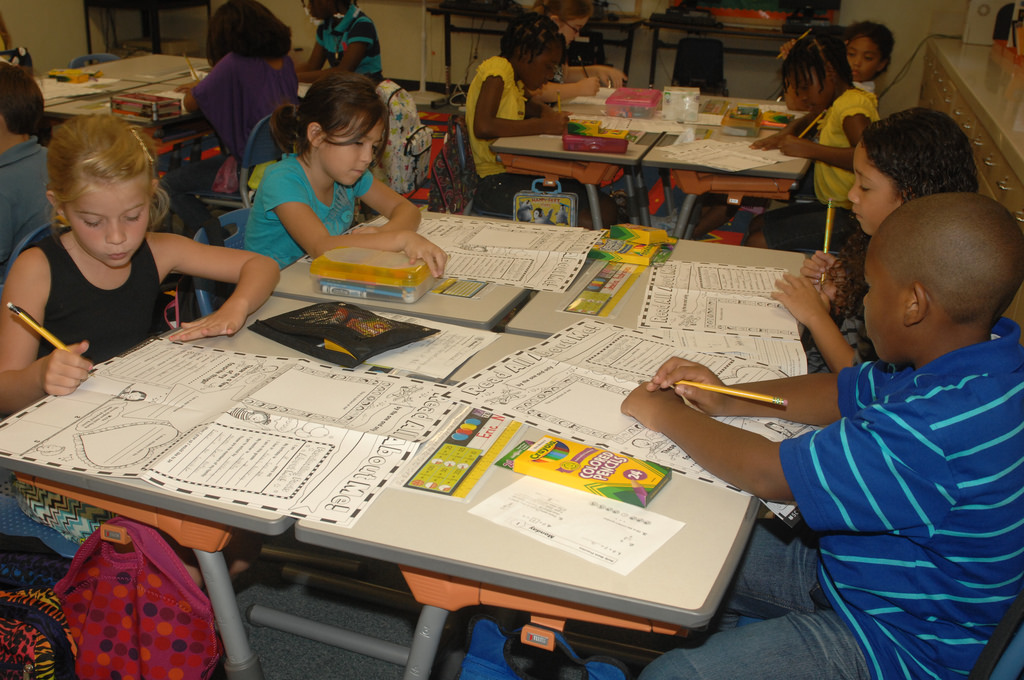1. Following instructions: why it matters
The ability to follow instructions like those above is a big advantage. It helps to carry out learning activities and to succeed in tests. It can make you seem more diligent and responsible (especially to teachers, workmates and peers). And it can help you to navigate to new places and to deal with new situations (e.g. high school, or jobs).
Many children and adults struggle to follow multi-step instructions, including many people with developmental language disorders.
Why?
Here are two likely candidates, which often – but not always – occur together:
(a) Too long! (Working memory limits)
Many people with low working memories fail to complete long, multi-step instructions. In particular, children with low working memory abilities struggle to follow instructions in everyday classroom situations (Gathercole et al., 2006).
In the classroom, kids with low working memory:
-
often complete the first one or two parts of the instruction (e.g. putting their homework on the table and their readers in the folder) before giving up;
-
sometimes, complete only the last step (e.g. sitting on the floor); and
-
learn (over time) to compensate, e.g. by watching and copying what the other kids are doing, or doing what you normally do with the objects mentioned. Strategies like these can sometimes mask kids who have problems understanding instructions.
Verbal working memory is closely linked with the ability to follow multi-step instructions. Following long instructions (e.g. ‘First, touch the red one, then the blue one, then the orange one, and then draw a circle around them all’) requires you to hold all the detailed content of the sequence while monitoring yourself carrying them out at the same time. This capacity to maintain information while engaged in other activities requiring the brain is a key feature of working memory (e.g. Baddely, 2012).
Working memory supports the retention of activity-specific and classroom management instructions at school (Gathercole & Alloway, 2006). Working memory is closely linked with children’s abilities to perform task instructions such as ‘Pick up the red pen and then touch the blue folder’ (e.g. Gathercole et al., 2008).
It’s even harder for people to remember instructions when you have to remember the later steps for several minutes while you attend to earlier steps (e.g. ‘First, finish your maths questions, and then I want you to write me a story about what you did on holidays.’). When the time needed to complete the instructions exceeds the duration of your working memory (usually somewhere between 2 and 18 seconds), you have to actively maintain the instructions in your working memory, e.g. by rehearsal (retelling yourself the instruction out loud or ‘in your head’, over and over) (e.g. Camos et al., 2009).
(b) Oral language difficulties and disorders
(i) Vocabulary and semantic problems:
Obviously:
-
if you don’t know the names of colours, you will have difficulty following instructions that ask you to ‘Point to the blue one, then the red one’; and
-
if you don’t know your basic position words (prepositions), you may struggle to follow instructions that ask you to ‘Put your hat on the table, and your bag under your chair.’. (This is the kind of instruction where kids with difficulties will look at what others are doing.)
Many kids who are learning English as a second language, and kids with developmental language disorders, do not understand language concepts that many of us take for granted, e.g. words many of use in every day instructions, like ‘first’, ‘then’, ‘before‘, ‘after‘, ‘if’, ‘except‘, ‘when’, ‘unless’, ‘until’, and ‘while’. (As an aside, this is one reason, I prioritise words like these for preschoolers and young school age children with developmental language disorders.)
(ii) Complex syntax problems
Many people who are learning English as a second language and people with developmental language disorders have difficulty processing complex sentences. For example, consider these sentences, using the language concepts ‘before’ and ‘after’:
Go and eat your lunch after you’ve cleaned up your desk.
All four of these sentences mean exactly the same thing! No wonder many kids – and adults – get confused!
In practice, many kids with language disorders will do things in the order they hear the steps, which can lead to errors when the word order doesn’t match the order or tasks (e.g. ‘Go and eat your lunch after you’ve cleaned up your desk’).
Here’s another example:
‘Go and ask that boy who was chased by Mark to come and see me in the Principal’s office.’
This sentence uses complicated syntax, which is hard for many kids to process and understand. Many kids with language difficulties will dutifully go off and get Mark, rather than the boy who was chased by Mark.
2. Practical tips to help people who have difficulties with multi-step instructions
In language therapy, we help by:
-
working on language concepts frequently used in instructions; and
-
practising using items and instructions based on those used in the client’s real world (e.g. in the classroom, workplace).
To date, working memory training has had some success in boosting kids’ performance on tasks similar to those practised. But there is (as yet) little reliable evidence that it enhances performance on more practical everyday tasks (Jaroslawska, et al., 2016).
Teachers, family members, bosses, and others can adopt a few, common sense suggestions to make life easier for people who have difficulties following instructions:
-
Speak slowly and clearly when giving instructions. Avoid too much background noise.
-
Break multi-step instructions into single steps, e.g ‘Please clean your desk. Now go to lunch’.
-
Use the ‘When…then’ technique to replace complex instructions with simpler ones (e.g. instead of ‘Before you go to lunch, clean up your desks’, say ‘WHEN you finish cleaning your desk, THEN you can have lunch.’).
-
Use actions, modelling, pictures and/or videos to support everyday routine instructions. For example:
-
Use actions to accompany your instructions.
-
Show students how to complete the task by doing it yourself in front of them.
-
Draw simple (e.g. stick figure) comics showing each step of the instruction.
-
Make short videos of you carrying out the steps, e.g. on your smart phone, iPad or smartboard.
-
-
If students can read, provide written notes summarising the steps.
-
Repeat instructions, using actions words (verbs) as the person is about to carry out the step.
For a longer list of practical tips to help students with language difficulties at school, go here.
Related articles and resources:
- ‘In one ear and out the other’. FAQs: working memory and language disorders
- Speaking for themselves: why I choose ambitious goals to help young children put words together
- 24 practical ways to help school-aged children cope with language and reading problems at school and home
- Practising complex sentences with subordinate conjunctions including ‘if’, ‘when’, ‘unless’, ‘until’ and ‘while’
Principal sources:
Jaroslawska, A. J., Gathercole, S.E., Logie, M.R., Holmes, J. (2016). Following instructions in a virtual school: Does working memory play a role? Memory Cognition, 44:580-589.
Gathercole, S.E., Durling, E., Evans, M., Jeffcock, S., & Stone, S. (2008). Working Memory Abilities and Children’s Performance in Laboratory Analogues of Classroom Activities, Applied Cognitive Psychology, 1019-1037.
Image: https://tinyurl.com/y7gorc92

Hi there, I’m David Kinnane.
Principal Speech Pathologist, Banter Speech & Language
Our talented team of certified practising speech pathologists provide unhurried, personalised and evidence-based speech pathology care to children and adults in the Inner West of Sydney and beyond, both in our clinic and via telehealth.

